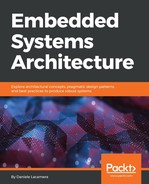Among all the possibilities in the wireless universe, 802.11 Wi-Fi is chosen for its high-speed, low-latency channel, and for the widest possible compatibility in a topology including personal computers and mobile devices. However, the power requirement of a Wi-Fi transceiver can sometimes be difficult to afford for low-power devices. The complexity of protocols and mechanisms to regulate media access requires a consistent amount of controlling software, which is often distributed in binary form, and thus impossible to debug and maintain without the support of the manufacturers.
Wi-Fi provides large bandwidth and reasonably low latency, and may implement authentication and encryption at the data-link level.
While it is technically possible to realize a local mesh network configuring the Wi-Fi transceivers to operate in an ad hoc mode, embedded systems equipped with 802.11 technology are mostly used to connect to existing infrastructures to interact with other portable devices and to access the internet.
Several embedded low-cost platforms are available on the market, equipped with a TCP/IP stack and a built-in RTOS, which can be used as a standalone platform or integrated in complete systems to access Wireless LAN, either as a station, or providing an access point.
